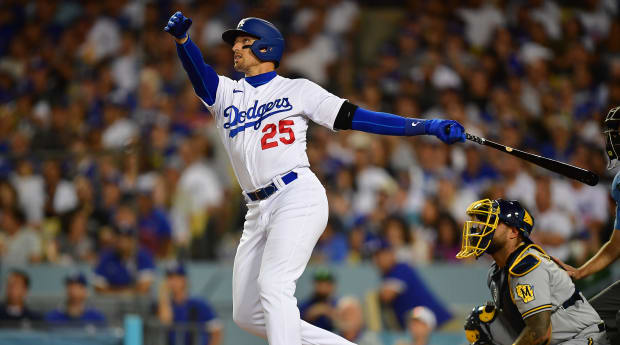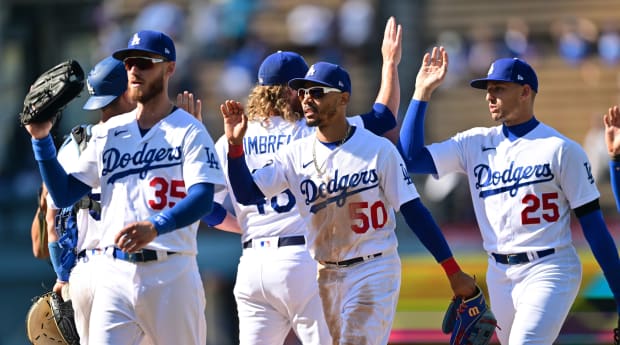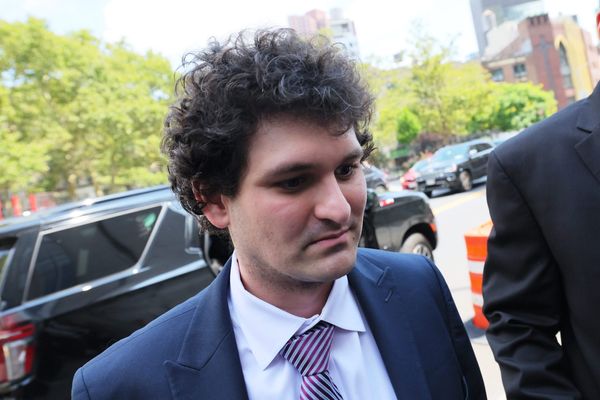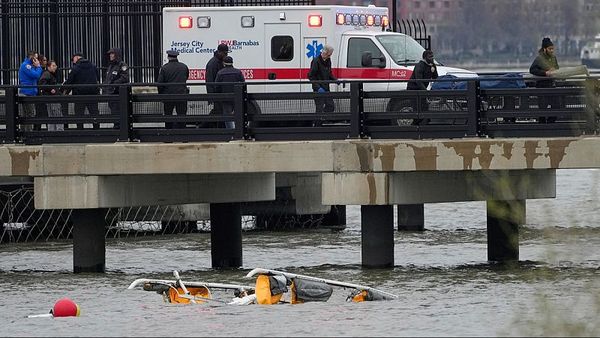Dodger Stadium carries the architectural distinction of being the only major league ballpark carved into the side of a ravine, making it also the only major league ballpark that players enter from above the nosebleed seats.
Trayce Thompson always believed he would make it back there, but he could never know for sure, so every day, he leaves for work just a minute or two early. He pulls into the player parking lot and enters on the eighth floor, high above home plate, and takes the stairs down a level. He strolls out into the stands, where the best view in baseball unfolds beneath him. Then he pauses. Sometimes he prays. Sometimes he just breathes. It’s an emotional way to start the workday.
He chuckles, wondering what the cleaning crew must think. The ones who know his story probably understand why he needs that time: He was a second-round pick and phenom until he broke his back with the Dodgers in 2016; he has passed through eight organizations and recorded 395 major league plate appearances in the six years since. But a July trade back to Los Angeles, intended just to cover for injuries, has reignited something in the outfielder, and in only 50 games, at 31, he has been the ninth-most valuable player on the best team in baseball. He has forced himself into the starting lineup most days. He has regained his health, received help from his hero, resuscitated his career. So every day, when he arrives at Dodger Stadium, he says thank you.
“I would’ve foreseen playing there again, but to put this uniform on, being in this locker room—it’s something that I’m very grateful for every day,” he says.
The people around him, many of whom have known him since he was 25 and on a star track, have noticed.
“I think that’s what gravitates me toward him, and what pulls me to root for him, because I just don’t think there’s enough people in our game—or in the world—that have gratitude, and Trayce has gratitude,” says manager Dave Roberts. Roberts tries to believe that he loves all his players equally, but he knows that’s not quite true. Thompson’s success feels special.
“Given his ups and downs and having to go back to the minors and scratch and claw his way back and overcome injury and [now he’s] making an impact for our ballclub, it’s certainly gratifying,” Roberts says. “And also then you layer in on the character of this guy, there’s no one better.”

Gary A. Vasquez/USA TODAY Sports
It was Thompson’s character that has made him so hard to cut over the years. Thompson grew up around sports—his father, Mychal, played 13 years in the NBA and won two titles with the Lakers; his mother, Julie, played volleyball at the University of Portland and the University of San Francisco; his oldest brother, Mychel, played for the Cavaliers; and his middle brother, Klay, has won four championships with the Warriors—and he tends to elevate his teammates. General managers take a flier on Thompson because of his talent, hold on to him because of his makeup and eventually jettison him in favor of someone else, lamenting to reporters how much they liked him and wanted to make it work.
In 2016, it seemed it would work in Los Angeles. The White Sox had chosen Thompson out of Santa Margarita Catholic (Rancho Santa Margarita, Calif.) in the second round of the ’09 draft, then traded him after a strong rookie season to the Dodgers as part of the three-team deal that sent Todd Frazier from the Reds to the Sox. Thompson made the Opening Day roster and had 10 home runs and a .922 OPS through the first week of June. But his back began to hurt, and he hit .168 over the next 31 games as he changed his mechanics to alleviate the pain. An MRI showed nothing, but an X-ray found two fractured vertebrae.
Thompson missed the rest of the year and spent his offseason rehabbing. His body returned to form. His play did not. He held on to many of the bad habits he had picked up playing through the injury. He lost faith in himself. He had a .483 OPS in 27 major league games in 2017. The Yankees claimed him off waivers the following spring; two days later, the A’s claimed him from them. He hit .117 in 51 games for Oakland and the White Sox in ’18, struggled at Triple A for Cleveland in ’19 and spent ’20 at the Diamondbacks’ alternate site.
“I’ve been completely healthy since [the injury],” he says. “Just, for lack of a better word, I sucked, and I had to figure it out and kind of rediscover myself.”
He played well enough at Triple A for the Cubs last year to earn a September call-up but couldn’t do better than a minor league deal with the Padres this spring. They designated him for assignment, and he signed a minor league deal with the Tigers, where he was tearing up their Triple A affiliate when Dodgers backup outfielder Kevin Pillar broke his left shoulder in early June.
Two weeks later, right fielder Mookie Betts cracked a rib colliding with Cody Bellinger. Suddenly the Dodgers’ right-handed outfield depth—once so enviable that they traded AJ Pollock to the White Sox this spring—had evaporated. Thompson had made an impression during his first stint with the team all those years ago, so L.A. picked him up for cash considerations. Since then, he has hit .296 with seven home runs in 156 plate appearances.
“I’ve had so many people reach out to me to say, ‘[You] can play for the Dodgers, but [you] can’t play for the Detroit Tigers?’” he says. “But in a way it makes sense, because the Tigers are at the point where, you know, they’re probably not gonna make the playoffs this year. So they kind of have to see what they got for next year, and so they need to play these young guys and see what they can do.”
Thompson knows what he can do. He says he is not surprised by his success in Los Angeles. “Actually, I should be doing better,” he says. “I’ve struck out way too much, in my opinion. I haven’t hit lefties up to my standard and up to what I expect to, so I feel like there’s a lot more in the tank.”
He has always known he was capable of this performance, he says, but he needed some help to get there. He has received it from his friends and family and coaches and teammates, but there is also someone else who has changed the trajectory of his career.

Jayne Kamin-Oncea/USA TODAY Sports
When Thompson signed with the Diamondbacks in 2020, he mentioned to director of player development Josh Barfield that his favorite player as a child had been Barfield’s Cleveland teammate Grady Sizemore, like Thompson a product of the Pacific Northwest. (Thompson grew up in Portland, before moving to Southern California for high school; Sizemore is from Everett, Wash.) Thompson gaped as Sizemore became a three-time All-Star before knee and back injuries ended his career after only 10 seasons. Barfield “put him on the spot immediately and started a group text,” Sizemore says, laughing.
Sizemore’s last year, 2015, was Thompson’s first, and he remembered hearing about the kid at the time, but he hadn’t followed his career. They stayed in touch casually at first, until one day in ’21 when Thompson asked Sizemore for advice. They reviewed film together, and Sizemore began paying closer attention so he could offer useful feedback going forward.
“I just try to be helpful,” Sizemore says. “When we first started talking, he was still in the minor leagues and he was scuffling a little bit, so I had to step away. I was like, Maybe I'm hurting him more than I’m helping him. So I was like, Stop texting him and stop calling him; let him be. I felt really bad. He sent me a text maybe a month later—and I hadn’t really checked on him, I didn’t watch video, I just kind of put it away—and he was thanking me for all this stuff, saying how it kind of clicked and felt good. And I felt so relieved. I didn’t screw this guy up too bad! You always want to be careful. But I’m glad I could be helpful. It’s fun.”
These days, they talk, at minimum, twice a month. “I still can’t believe I have his number,” Thompson says. Sizemore might seem like the perfect person to counsel Thompson on persevering through injuries, but Thompson has never mentioned his. Sizemore did not learn of Thompson’s broken back until a reporter asked him about it. Sometimes Sizemore will suggest a minor mechanical change, but more often they discuss approach. Thompson had so much success so early that he had not fully honed his mentality for when things went wrong. He had to learn to feel comfortable with falling short, with trusting a process even when the results look bad. “Failure really gives us answers to how to get better,” he says.
Sometimes Sizemore senses that Thompson feels overloaded by information, so he tries to keep his advice simple. You are good at this, he reminds his protégé. That’s how you got here. He sometimes adds, You’re on a team full of All-Stars, and they can’t keep you out of the lineup. Sizemore emphasizes that when the swing feels wrong, it’s not usually the swing; it’s something leading up to the swing. “Your timing,” he says. “Whether you’re carrying a bad at bat or a bad stretch or playing time, a lot of it is just timing. So I’m just trying to work within his swing and help him be in a better position to have success.”
Sizemore worked briefly as an adviser to the Guardians in player development after he retired, but he has been out of the game officially for a few years. In that time, he has mostly focused on raising his three young children. He thought he had put baseball behind him. His relationship with Thompson has brought him back to the game he never stopped loving. “That’s probably the one part you miss the most is just the little things, you know,” Sizemore says. “The day-to-day grind, just working on your craft. Now you’re just trying to pass that on to someone else and trying to help him, and that teaches me. I’m learning to break down things different ways. So you know, I’m just trying to teach myself and help someone else at the same time.”
He and his wife, model and actress Brittany Binger, watch most Dodgers games on TV; when Sizemore misses one, he records it so he can catch it later. He thinks he might start following L.A.’s upcoming opponents so he can scout how pitchers might attack Thompson. The Dodgers are tearing toward a division title and a first-round bye. Maybe Sizemore, who lives in Arizona, can find his way to Los Angeles this October. Then he and Thompson can both look out over Dodger Stadium and feel grateful to be there.







